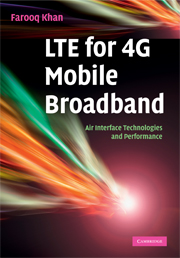Book contents
- Frontmatter
- Contents
- Preface
- 1 Introduction
- 2 Network architecture and protocols
- 3 Downlink access
- 4 Single-carrier FDMA
- 5 Reducing uplink signal peakiness
- 6 Transmit diversity
- 7 MIMO spatial multiplexing
- 8 Channel structure and bandwidths
- 9 Cell search and reference signals
- 10 Random access
- 11 Channel coding
- 12 Scheduling, link adaptation and hybrid ARQ
- 13 Power control
- 14 Uplink control signaling
- 15 Downlink control signaling
- 16 Inter-cell interference control
- 17 Single frequency network broadcast
- 18 Spatial channel model
- 19 LTE performance verification
- Index
4 - Single-carrier FDMA
Published online by Cambridge University Press: 28 February 2011
- Frontmatter
- Contents
- Preface
- 1 Introduction
- 2 Network architecture and protocols
- 3 Downlink access
- 4 Single-carrier FDMA
- 5 Reducing uplink signal peakiness
- 6 Transmit diversity
- 7 MIMO spatial multiplexing
- 8 Channel structure and bandwidths
- 9 Cell search and reference signals
- 10 Random access
- 11 Channel coding
- 12 Scheduling, link adaptation and hybrid ARQ
- 13 Power control
- 14 Uplink control signaling
- 15 Downlink control signaling
- 16 Inter-cell interference control
- 17 Single frequency network broadcast
- 18 Spatial channel model
- 19 LTE performance verification
- Index
Summary
The design of an efficient multiple access and multiplexing scheme is more challenging on the uplink than on the downlink due to the many-to-one nature of the uplink transmissions. Another important requirement for uplink transmissions is low signal peakiness due to the limited transmission power at the user equipment (UE). The current 3G systems use the wideband code division multiple access (WCDMA) scheme both in the uplink and in the downlink. In a WCDMA downlink (Node-B to UE link) the transmissions on different Walsh codes are orthogonal when they are received at the UE. This is due to the fact that the signal is transmitted from a fixed location (base station) on the downlink and all the Walsh codes received are synchronized. Therefore, in the absence of multi-paths, transmissions on different codes do not interfere with each other. However, in the presence of multi-path propagation, which is typically the case in cellular environments, the Walsh codes are no longer orthogonal and interfere with each other resulting in inter-user and/or inter-symbol interference (ISI).
The problem is even more severe on the uplink because the received Walsh codes from multiple users are not orthogonal even in the absence of multi-paths. In the uplink (UE to Node-B link), the propagation times from UEs at different locations in the cell to the Node-B are different. The received codes are not synchronized when they arrive at the Node-B and therefore orthogonality cannot be guaranteed.
- Type
- Chapter
- Information
- LTE for 4G Mobile BroadbandAir Interface Technologies and Performance, pp. 70 - 87Publisher: Cambridge University PressPrint publication year: 2009
- 1
- Cited by

